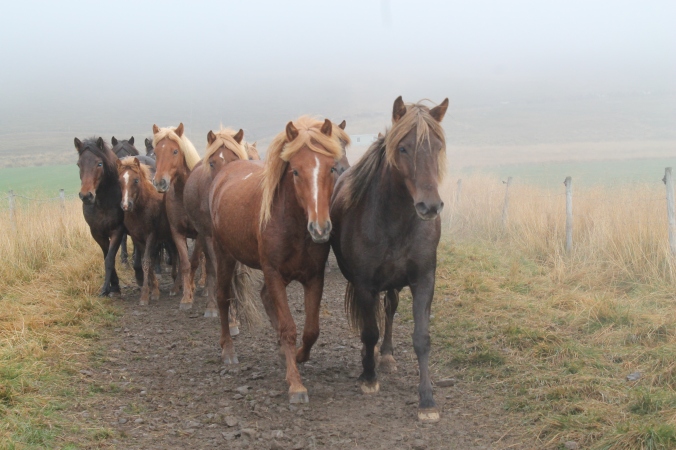
On a cold, autumn afternoon, across the pastoral landscape of Iceland’s Kolbeinsdalur valley, you can hear a gentle-rumbling that originates over a fog-laden hill. Breaking through the fog is a large herd of Icelandic horses, guided by wranglers. Today is the annual smala hrossum (the gathering) of the herds from their summer pastures which has attracted Icelanders and tourists from far and wide to this small valley in northern Iceland. These annual roundups take place all over northern Iceland but this particular roundup, on the west side of the Tröllaskagi peninsula, is known as Laufskálaréttir and is the biggest in Iceland
A weekend to celebrate tradition
Laufsálaréttir begins Friday with celebrations including a horse show for the locals at the municipal barn in the town of Sauðárkrókur, a part of the Skagafjörður municipality in northern Iceland. After the round-up on Saturday, a variety of pre-parties occurs in the area followed by the grand finale of the day’s festivities. In what is one of the largest gatherings of the year, the residents and visitors come together at 11 p.m. (or 23:00 to Icelanders) for music, dancing and an all-around enjoyable time until the early morning hours.

The Icelandic horse has over 40 colors and 100 variations of color.
Smala hrossum and rettir
Each summer farmers select mares, foals, and geldings, to roam free in the pastures and highlands near their farms for the summer. In September farmers, family, and friends ride out to collect their herds and return them to the comfort of their stables and pasture lands to seek respite from the harsh winter. Even a few paying tourists can engage in this age-old tradition of gathering horses and wrangling them to the communal sorting pens, to be collected by their owners, a tradition known as rettir. But you do not have to be a wrangler to enjoy this event, hundreds of Icelanders and tourists descend upon the area with their video cameras, cell phones, and even drones to capture the excitement. Kári Árnason, a resident of Sauðárkrókur, has been participating in this event for over 30 years. To him and other residents, the roundup is a necessary part of life and find it puzzling that Icelanders and tourists have now become an integral part of the tradition.
Ingunn Ingólfsdóttir is a local resident and a junior in high school. She has been riding horses as long as she can remember and has been competing in local competitions since she was six years old. Her family’s farm, Dýrfinnustaðir, is a local business with nearly 200 horses that caters to tourists who want the Laufskálaréttir experience of wrangling the horses from their summer homes. Ingunn’s job is to saddle those horses for the tourists and lead them out to gather horses, a job that is usually tasked by men. In fact, Ingunn is one of the few females who have this job and as a high school student, she certainly has my admiration. After high school, Ingunn will attend Hólar University in the Equine Studies department. In the future, she hopes to teach riding around the world where Icelandic horses are becoming more prevalent.
As I experienced rettir for the first time, it was plain to see that the tradition not only rounds up the horses, but it appears to round up the families and residents to maintain the connection that Icelanders have, to nature and their history.

Ingunn and her horse, Bálkur frá Dýrfinnustöðum.
Don’t call them ponies
The stars of the weekend are the Icelandic horses, whose docile behavior coupled with strength have been selectively bred for over a thousand years. Though smaller than other breeds, they have been mistakenly called ponies, but their strength proves otherwise. Horses first arrived in Iceland with the Vikings but were soon after prohibited from being imported, a practice that is still the law today. Because they have been selectively bred to work in the rugged and harsh landscape of Iceland prohibiting horses from being imported into Iceland ensures the genetic integrity of the breed. In fact, if you want to compete in a horse competition outside of Iceland, Icelandic law prohibits your horse from returning. Recently, Icelandic horses have become big business in some countries, and it is easy to understand why. Their friendly disposition and their strength have made them desirable around the world.
So, if you happen to be in northern Iceland in late September, I highly recommend experiencing Laufskálaréttir, and if you want to experience it in true Icelandic fashion, you can find Ingunn’s family farm, Dýrfinnustaðir, on Facebook!

Icelandic horses are mistakenly called ponies sometimes, but their strength says otherwise






































They look thick but how tall? Maybe 13.5 hands? Good lookin critters
LikeLike
Thank you for visiting, Peter! You’re right! 13-14 hands which apparently is pony size elsewhere. They are beautiful and I didn’t even talk about the unique gait they have called tölt!
LikeLike